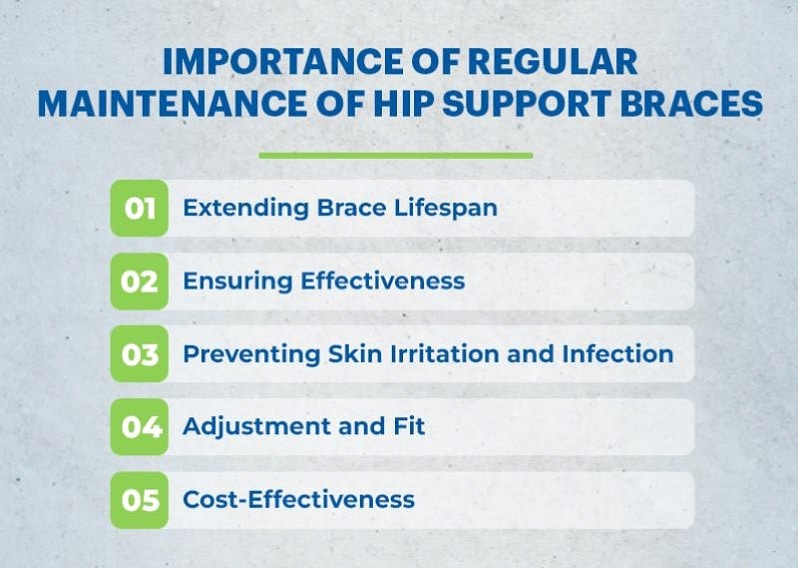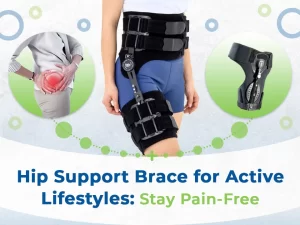Hip support braces play a critical role in recovering and rehabilitating individuals who have experienced hip injuries or undergone surgeries. This comprehensive article is designed to provide in-depth guidance on the proper maintenance and care of hip support braces. By focusing on keeping these braces in optimal condition, the article aims to ensure they continue functioning effectively, offering the necessary support and comfort for those who rely on them during their recovery journey.
Understanding Hip Support Braces
Hip support braces are specialized devices designed to provide support, stability, and pain relief for individuals experiencing hip-related issues. Here’s an exploration of their purpose, function, and the various types available:
- Purpose and Function of Hip Braces: Hip braces stabilize and support the hip joint and surrounding muscles. They are commonly used for injury recovery, post-surgical support, arthritis management, and sports injury prevention. Limiting excessive movement and providing compression help reduce pain and inflammation, accelerate healing, and prevent further injury.
- Types of Hip Braces: There are several types of hip braces, each designed for specific conditions and needs:
- Compression Braces: Made of elastic materials, these provide gentle support and are often used for mild hip discomfort and muscle strains.
- Stabilizing Braces: These are more rigid and provide greater support to the hip joint, ideal for post-surgical recovery or more severe injuries.
- Hip Abduction Braces: Designed to maintain the hip in a specific position, these braces are often used after hip surgeries, like hip replacements or repairs of hip dysplasia.
- Activity-Specific Braces: Custom-designed braces for specific sports or activities, providing support while allowing necessary movement.
- Adjustability and Customization: Many hip braces offer adjustable straps and components, allowing for a custom fit that accommodates different body sizes and shapes. This adjustability is crucial for comfort and effective support.
- Materials and Comfort: Hip braces are made from various materials, including neoprene, foam, and breathable fabrics. The choice of material affects the brace’s comfort, breathability, and level of support.
- Integration with Physical Therapy: Often, hip braces are used in conjunction with physical therapy exercises. They can provide the necessary support during rehabilitation exercises, helping patients regain strength and mobility more safely.
By understanding the various types of hip braces and their specific functions, individuals can make informed decisions about their use and integrate them effectively into their recovery or pain management plan.
Importance of Regular Maintenance of Hip Support Braces
Regular maintenance of hip support braces is crucial for their longevity and effectiveness. Proper care ensures that these medical devices continue to provide the intended support and comfort over time. Here’s a discussion on the importance of regular maintenance:

The crucial role of regular maintenance in keeping hip support braces in top condition.
- Extending Brace Lifespan: Proper maintenance, such as regular cleaning and storing the brace correctly, extends its functionality. This care helps the materials like elastic, foam, or fabric to stay in good condition, preventing premature wear and tear.
- Ensuring Effectiveness: Regular care is essential to keep the brace effective. A well-maintained brace maintains its structural integrity, ensuring it provides the correct level of support and compression. This is crucial for braces used in medical recovery or for managing chronic conditions.
- Preventing Skin Irritation and Infection: Keeping the brace clean prevents skin issues. Accumulation of sweat, dirt, and bacteria can cause skin irritation or infection, which can be mitigated with proper hygiene practices.
- Adjustment and Fit: Braces may stretch or lose shape over time. Regular maintenance includes checking and adjusting the fit to ensure the brace offers proper support and comfort. An ill-fitting brace can reduce effectiveness and potentially cause further issues.
- Cost-Effectiveness: Properly maintaining a hip brace reduces the need for frequent replacements, making it a cost-effective option in the long run. This is especially significant for individuals requiring long-term brace use.
Regular maintenance of hip braces is not just about preserving the physical product; it’s also about ensuring the health and safety of the user, as well as maximizing the therapeutic value of the brace. Individuals can greatly benefit from their hip brace’s full potential by dedicating time to proper care and attention.
Cleaning and Storage
Maintaining the condition of hip support braces through proper cleaning and storage is essential. Here’s a guide on cleaning techniques and storage tips for these braces:
Cleaning Techniques
- Read Manufacturer Instructions: Always start by reading the cleaning instructions provided by the manufacturer, as different materials may require specific care.
- Mild Soap and Water: A gentle hand wash with mild soap and lukewarm water is sufficient for most braces. Avoid using harsh detergents, as they can degrade the material.
- Soft Cloth or Sponge: Use a soft cloth or sponge to clean the brace gently. Avoid abrasive materials that can damage the brace.
- Air Dry: After washing, dry the brace away from direct sunlight and heat sources. Do not use a dryer, as the heat can warp or shrink the materials.
- Regular Cleaning: Clean the brace regularly, especially if worn directly against the skin. This helps prevent buildup of sweat, oils, and bacteria.
Storage Tips
- Dry Completely Before Storing: Ensure the brace is completely dry before storage to prevent mold and mildew growth.
- Cool, Dry Place: Store the brace in a cool, dry place. Avoid areas with high humidity or extreme temperatures, which can affect the brace material.
- Maintain Shape: When storing, keep the brace in its natural shape. Avoid folding or rolling it in a way that might crease or stretch the material.
- Avoid Direct Sunlight: Store the brace away from direct sunlight, as UV rays can degrade certain materials over time.
- Separate Storage Bag: Consider using a separate storage bag or container to protect the brace from dust and other environmental factors.
Following these cleaning and storage guidelines can significantly extend the life and effectiveness of a hip support brace. Treating these medical devices with care is important to ensure they continue providing the necessary support and comfort.
Inspection, Minor Repairs, and Adjusting Your Brace
Maintaining a hip support brace involves regular inspections, minor repairs, and adjustments to ensure it continues to function effectively. Here’s a guide on how to manage these aspects:
Regular Check-ups
- Frequent Inspections: Regularly inspect the brace for signs of wear and tear, such as fraying straps, loose seams, or breakdown of materials.
- Check for Structural Integrity: Ensure all brace parts are intact and functioning as they should, especially if they include rigid components.
- Look for Changes in Comfort: Any discomfort or changes in the brace’s feelings may indicate wear or damage.
Handling Repairs
- DIY Minor Repairs: Small issues like loose threads or minor fraying can often be fixed at home with basic sewing skills or appropriate adhesive.
- Replace Worn Parts: Some braces have replaceable parts like straps or pads. Check if these can be ordered and replaced individually.
- Professional Assistance: Seek professional repair services for significant damage, especially in braces with complex mechanisms. Never attempt to repair these yourself, as it could compromise the brace’s effectiveness.
Fit Adjustments
- Understand Adjustment Features: Familiarize yourself with the brace’s adjustable components like straps, Velcro closures, or buckles.
- Comfort and Support Balance: Adjust the brace for a snug fit that provides support without restricting circulation or causing discomfort.
- Regular Fine-Tuning: Make small adjustments regularly, especially if your body size changes or experience comfort or support level changes.
When to Seek Adjustments
- Signs of Poor Fit: If the brace consistently slips, causes discomfort, or fails to provide adequate support, it may need professional adjustment.
- Postural Changes or Healing: As your body heals or if your posture changes, the brace might need readjustment to accommodate these changes.
- Consulting a Professional: If you’re unsure how to adjust the brace or if adjustments don’t improve comfort or support, consult a healthcare professional or the manufacturer for advice or professional adjustment services.
Regular maintenance, including inspection, minor repairs, and adjustments, is essential for the effectiveness of a hip support brace. It ensures the brace remains in good condition, offering the necessary support and comfort for optimal functioning.
Read More: Unlock Your Mobility: Hip Braces Revolutionizing Rehabilitation
Dealing with Wear and Tear of Hip Support Braces
Maintaining the integrity of a hip support brace is crucial for its effectiveness. Over time, braces may exhibit signs of wear and tear, impacting their functionality. This section outlines identifying these signs and when to consider replacing the brace.

Maintaining top condition of hip support braces through proper maintenance to prevent wear and tear.
- Visible Material Wear: Recognizing signs like fraying fabric or stretched straps.
- Comfort and Support Assessment: Noting any changes in the level of support or comfort provided.
- Structural Integrity Checks: Inspect for damage to buckles, clasps, or rigid components.
- Response to Adjustments: Evaluate if the brace retains its shape and support after adjustments.
- Professional Assessments: The importance of regular check-ups by a healthcare professional for structural integrity.
- Replacement Timelines: Guidance on the typical lifespan of different types of braces and when to replace them based on usage.
Regular assessment and proper care of hip support braces are essential to ensure they continue providing the necessary support. Recognizing the signs of wear and understanding when to replace them will contribute significantly to the effectiveness of your recovery journey.
Conclusion
The article emphasizes the importance of regular maintenance in extending life and enhancing the effectiveness of a hip support brace. It highlights that consistent cleaning, proper storage, and routine checks are crucial in ensuring the brace remains in the best condition for optimal support and comfort. This comprehensive approach to brace care guarantees that users benefit from their hip support brace, contributing significantly to their recovery and daily comfort.
SEO Key Phrases
- Hip brace maintenance tips
- Caring for your hip brace
- Hip support brace cleaning
- Storing hip support braces
- Hip brace wear and tear
- Adjusting hip braces
- Hip brace repair advice
- Hip brace replacement guidelines







